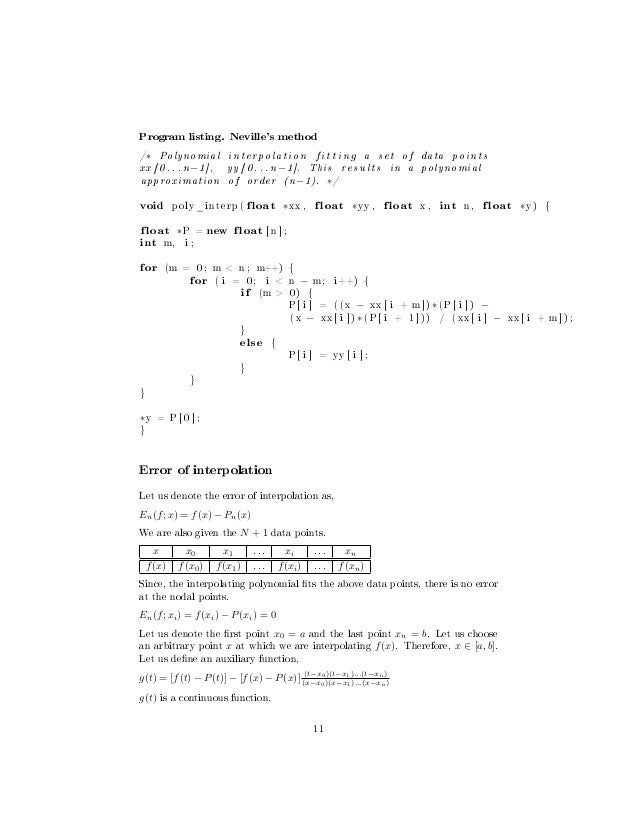Linear Program Polynomial Interpolation Matrix


• • • • • Interpolation Engineering problems often require the analysis of data pairs. For example, the paired data might represent a cause and effect, or input-output relationship, such as the current produced in a resistor as a result of an applied voltage, or a time history, such as the temperature of an object as a function of time. Another type of paired data represents a profile, such as a road profile (which shows the height of the road along its length).
In some applications we want to estimate a variable’s value between the data points. This process is called interpolation. In other cases we might need to estimate the variable’s value outside of the given data range. This process is extrapolation. Interpolation and extrapolation are greatly aided by plotting the data. Such plots, some perhaps using logarithmic axes, often help to discover a functional description of the data. Suppose that x represents the independent variable in the data (such as the applied voltage in the preceding example), and y represents the dependent variable (such as the resistor current).
In some applications the data set will contain only. One value of y for each value of x. In other cases there will be several measured values of y for a particular value of x.
Linear Program Polynomial Interpolation Matlab. Uniqueness can also be seen from the invertibility of the Vandermonde matrix. Linear Interpolation with Excel.
This condition is called data scatter. For example, suppose we apply 10 V to a resistor, and measure 3.1 mA of current. Then, repeating the experiment, suppose We measure 3.3 mA the second time. If we average the two results, the resulting data point will be x = 10V,y = 3.2 mA, which is an example of aggregating the data, In this section we assume that the. data have been aggregated if necessary, so only one value of y corresponds to a specific value of x. You can use the methods of Sections 7.1 and 7.2 to aggregate the data by computing its mean. The data’s standard deviation indicates how much the data is spread around the aggregated point. Suppose we have the following temperature measurements, taken once an hour starting at 7:00 A.M. The measurements at 8 A.M.
Are missing for some reason, perhaps because of equipment malfunction. 12 noon Temperature (ºF) 49 57 71 75 A plot of this data is shown in Figure 7.4-1 with the data points connected by, dashed lines.
If we need to estimate the temperature at 10 A.M., we can read the value from the dashed line that connects the data points at 9 A.M. From the plot wethus estimate the temperature at 8 A.M. To be 53°F and at 10 A.M. We have just performed linear interpolation on the data to obtain an estimate of the missing data. Linear interpolation is so named because it is equivalent to connecting the data points with a linear function (a straight line). Of course we have no reason to believe that the temperature follows the straight lines shown in the plot, and our estimate of 64°F will most likely be incorrect, but it might be close enough to be useful.
When using interpolation, we must always keep in mind that our results will be approximate and should be used with caution. In general, the more closely spaced the data, the more accurate the interpolation. Plotting the data sometimes helps to judge the accuracy of the interpolation. Using straight lines to connect the data points is the simplest form of interpolation. Another function could be used if we have a good reason to do so. Om Bogat Om Sarac Serial Romanesc Hbo Nitty Gritty Dirt Band Dance Little Jean Free Mp3 Download there. more. Later in this section we use polynomial functions to do the interpolation, Linear interpolation in MATLAB is obtained with the interp1 and interp2 functions. Suppose that x is a vector containing the independent variable data and that y is a vector containing the dependent variable data.
If x_int is a vector containing the value or values of the independent variable at which we wish to estimate the dependent variable, then typing interp1 (x,y, x_int). Figure 7.4-7 A plot of temperature data versus time produces a vector the same size as x_int containing the interpolated values of y that correspond to x_into For example, the following session produces an estimate of the temperatures at 8 A.M. From the preceding data. The vectors x and y contain the times and temperatures, respectively. » x = [7, 9, 11, 12]; » y = [49, 57, 71, 75); » x_int = [8, 10]; » interp1 (x,y,x_int) ans = 53 64 You must keep in mind two restrictions when using the interp1 function. The values of the independent variable in the vector x must be in ascending order; and the values in the interpolation vector x_int must lie within the range of the values in X.
Thus we cannot use the interp1 function to estimate the temperature. At 6 A.M., for example. The interp1 function can be used to interpolate in a table of values by defining y to be a matrix instead of a vector. For example, suppose we now have temperature measurements at three locations and that the measurements at 8 A.M. and 10 A.M.